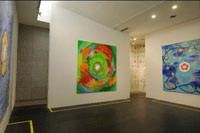 Guangzhou Triennial Is One China Art Festival Too Many: Review
Guangzhou Triennial Is One China Art Festival Too Many: ReviewSept. 30 (Bloomberg) -- ``The first thing I want to do when I get to Guangzhou, is leave,'' said Norman Ford, curator for the Hong Kong pavilion at the 2007 Venice Biennale, after visiting the southern Chinese city's biggest art festival.
This year's Guangzhou Triennial, the city's third attempt to lure the art world, is a fair too far. Never mind that it runs at the same time as the triennials in Nanjing and Yokohama or the Taipei and Singapore Biennales.
Those it could probably cope with. But Beijing and Shanghai have also just held flagship art shows. Even in the nation's gravity-defying contemporary art market, there are only so many collectors to go round.
Guangzhou is not the sexiest destination in Asia to hold an art show. The Guangdong Museum of Art, its new satellite, The Time Museum, and the Vitamin Creative Space are the only venues for the show. While Museum Director Wang Huangsheng deserves recognition for his ambitious exhibition program, it's hardly enough to create an arts capital.
The quality of the art on offer was hit or miss and the distribution awkward. Too many rooms on the first level had documentary-like installations of the kind French artist Christian Boltanski was doing 15 years ago. Too many video pieces were crammed into a single room on the third level.
Perhaps sensing the weight of competition, curators Gao Shiming, Sarat Maharaj and Johnson Chang Tsong-zung broadened the triennial from earlier versions to try to avoid being just another showcase for the next new thing in Chinese contemporary.
Long Explanation
For this year's show, ``Farewell to Post-Colonialism,'' the curators give a 650-word explanation of the title -- largely to do with freeing artists from the ``political correctness'' that has enveloped modern globalization and multiculturalism.
``The triennial's curators give elaborate explanations about the aim of the exhibition, but much of the art simply does not fit their intentions,'' said John Batten, a Hong Kong-based curator. ``It only gets in the way of the mostly excellent art on display.''
The Guangzhou Triennial is an attempt to bring together the whole Pearl River Delta Region -- including Hong Kong and Macau -- to make a mark on the international contemporary art scene.
``The opening was a debacle,'' said Ford, who is also a professor at Hong Kong Polytechnic University. ``It was overcrowded by visitors and by work. The Times Museum, where the second part of the show was held, wasn't even finished. Some of the work was set up in rooms with water leaking in.''
Chang said the main problem was a shortage of funds.
``The interior of Time Museum by Rem Koolhaas could not be finished on time and some of the artworks designated there could not be installed,'' he said. ``The museum needs to raise sponsorship. This is still a fair trade-off for not having to answer to official policy.''
African Art
Still, the event is more international than many Chinese art shows.
``The fact that quality Middle Eastern, African and Mexican artists were represented was unusual for Asia,'' Ford said.
The tented video installation by Liu Dahong, ``Faith on a Horse,'' is the starting point -- you have to walk through it to get in to the show. Chinese folk-style paintings decorate plastic windows and cloth walls of the tent, leading up to a video projected gong with accompanying sound.
Sculptures of a horse's head crown the two exits of the tent. The ensemble is meant to put us in the shoes of a Chinese person having lived through Chairman Mao Zedong's reign.
``Contemporary art is diverging in the strategies taken,'' said Chang. ``One level maintains a heady theoretical track and the other is breaking into a more gutsy, intuitive one.''
Chinese Demon
Amy Cheung's sculpture-and-sound installation ``Ashes Unto Pearl'' is part of the latter category. A deep purple meteorite- like sphere lets off sparks of light that draw the viewer in to look through holes in the surface to a Chinese demon-headed figure, while voices and sounds play around the work.
Behind Liu's tent are 16 paintings entitled ``China Painters'' by Christian Jankowski from Germany. He depicts the ideas Chinese art academies taught students -- examples of Western art, landscapes, Chinese portraiture and theater.
The works were done at Dafen Painting Village in Shenzhen, the art-forgery capital of the world and mounted on cement and scaffolding to evoke ``the hierarchies of art, the range of artistic production,'' said Chang.
Just as Dafen's output has exploded in the past few years, so China seems to be adding more and more art shows. Guangzhou will need to get better organized to stay in the competition.
``Farewell to Post-Colonialism'' runs through Nov. 18. For information, call +86 20 87351261, or go to http://www.gdmoa.org/zhanlan/threeyear/shannianzhanlink/.
 Guangzhou Triennial Is One China Art Festival Too Many: Review
Guangzhou Triennial Is One China Art Festival Too Many: Review